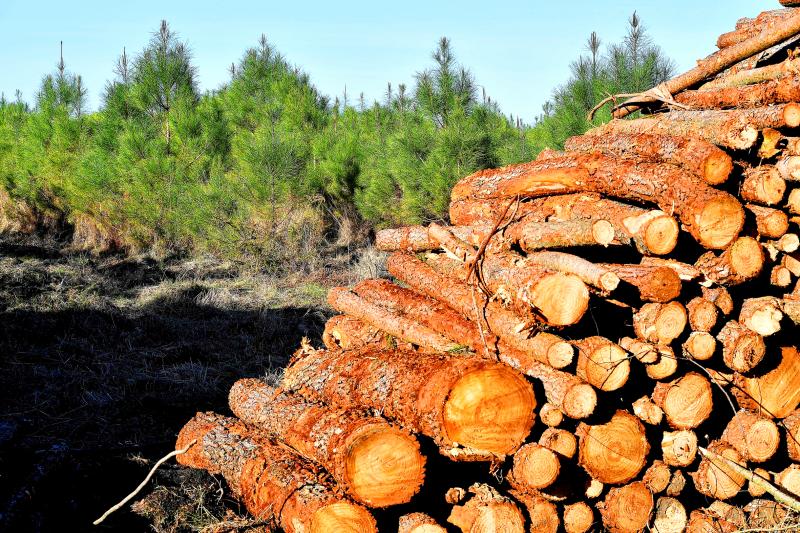Europe has lost a vastly increased area of forest to harvesting in recent years, data suggest, reducing the continent’s carbon absorption capacity and possibly indicating wider problems with the EU’s attempts to combat the climate crisis.
Many of the EU’s forests — which account for about 38 percent of its land surface area — are managed for timber production, and thus harvested regularly. But the loss of biomass increased by 69 percent in the period from 2016 to 2018, compared with the period from 2011 to 2015, according to satellite data. The area of forest harvested increased by 49 percent in the same comparison, published in the journal Nature Research.
This indicates that much more harvesting has occurred in a short period, even accounting for natural cycles and the impact of events such as forest fires and heavy snows. The harvested area could be expected to vary by less than about 10 percent owing to cycles of growing and planting and similar effects, according to Guido Ceccherini of the EU Joint Research Center, lead author of the study.

Photo: AFP 照片:法新社
Other factors are therefore likely to be in play, and these could include increased demand for wood as a fuel, and bigger markets for timber and other wood products. The satellite data could therefore be an early indicator of unsustainable demands being placed on the EU’s forests.
The loss of forest biomass is most pronounced in Sweden, which accounted for 29 percent of the increase in harvesting, and Finland, for about 22 percent. Much less affected were Poland, Spain, Latvia, Portugal and Estonia, which jointly accounted for about 30 percent of the increase in the 26 countries studied.
Ceccherini told the Guardian that the observed increase in harvesting and the loss of biomass was unlikely to result in a decline in the area of the EU that is forested overall, as most of the harvested forests would be regenerated, but that it would disrupt the carbon absorption capacity of the EU’s forests in the short term.
“The forests continue to remain a carbon sink, but less than before,” said Ceccherini. “Even if part of the harvested biomass carbon is used in long-lasting wood products, possibly replacing more energy-intensive materials such as steel or cement, most of it will return to the atmosphere as CO2 in a short period of time, [from] months to a few years. Until the carbon stock in harvested areas returns to previous levels, which takes several decades depending on the type of forest, an increase in harvest is therefore equivalent to an increase in carbon dioxide emissions to the atmosphere.”
Forests offset about 10 percent of the EU’s greenhouse gas emissions. As the areas harvested are likely to be replanted, the new growth will continue to absorb carbon dioxide from the atmosphere, so Europe’s carbon balance may not be greatly affected in the long term.
However, the researchers said it was important to find out why the harvesting has increased so suddenly, in case it indicates wider underlying problems with the way in which Europe’s forests are being managed. This study cannot definitively establish the causes of the increases in harvesting, so more research is needed.
Thomas Crowther, founder of Crowther Lab, who was not involved in the research, said: “It is concerning to see that the increasing demand for forest products may be reducing the carbon stored within living biomass in European forests. It is possibly more concerning that forest removal may also threaten the storage of carbon below ground. These high-latitude forests support some of the largest soil carbon stock on earth. If forest clearing threatens the integrity of high-latitude soil carbon stocks, then the climate impacts may be stronger than previously expected.”
(The Guardian)
資料顯示,歐洲近年因為採伐林木,失去的森林面積大幅增加,導致這塊大陸的碳吸收能力降低,同時暗示歐盟對抗氣候危機的嘗試可能有更廣泛的問題。
歐盟境內的森林約佔其陸地面積的百分之三十八,其中許多座森林皆受管理,用於生產木材,也因此會定期砍伐。不過,衛星資料顯示,跟二○一一到二○一五年期間相比,二○一六到二○一八年期間失去的生物量增加了百分之六十九。在同一份比較中,遭到砍伐的森林面積也增加了百分之四十九。該研究日前發表於《自然研究》期刊。
這個現象顯示,就算把自然週期以及森林大火或大雪等事件的影響都算進來,短期內仍出現比以往更大量的砍伐。該研究的主要作者、歐盟聯合研究中心的奎多‧塞切里尼表示,由於樹木生長與種植週期不同,加上各種因素影響,砍伐面積出現變化是可預期的,但是不會超過百分之十。
因此,砍伐面積大幅增加可能還涉及其他因素,包括木材作為燃料的需求增加,以及林木和其他木製品的市場擴大。因此,衛星資料或可作為一項早期指標,顯示歐盟境內的森林背負著無法永續發展的過量需求。
瑞典損失的森林生物量最為顯著,該國森林砍伐面積成長佔全歐盟的百分之二十九,芬蘭佔百分之二十二。波蘭、西班牙、拉脫維亞、葡萄牙和愛沙尼亞則是影響小很多的國家,在該研究涵蓋的二十六個國家中,總共佔百分之三十。
塞切里尼向衛報表示,研究觀察到的砍伐增加和生物量損失,不太可能導致歐盟境內被森林覆蓋的區域全面性減少,因為絕大多數被砍伐收成的森林會重新種上樹木。可是,此現象會擾亂歐盟境內森林短期內的碳吸收能力。
「這些森林仍然具有碳匯功能,但是沒有以前那麼多。」塞切里尼指出:「就算砍伐收成的生物量碳被用於耐用的木製品,或許代替鋼鐵或陶瓷等更能源密集的材料,絕大多數仍會在幾個月到數年的短時間內,以二氧化碳的形式回到大氣層中。在採伐區域的碳存量恢復到先前程度之前──根據森林類型,這個過程會耗費數十年──收成增加就等於二氧化碳進入大氣層的排放量增加。」
森林約抵銷歐盟百分之十的溫室氣體排放量。由於砍伐後的地區應該會重新種植樹木,新生長的樹木將會繼續從大氣層中吸收二氧化碳。長遠來看,歐洲的碳平衡也許不會嚴重受到影響。
儘管如此,研究人員表示,找出樹木收成突然增加的原因很重要,因為這可能指向歐洲管理森林方式的深層問題。這份報告無法確切對採伐林木增加的原因做出定論,還需要更多研究。
柯勞瑟實驗室的創辦人湯瑪斯‧柯勞瑟並非這項研究的參與者,但他指出:「看到林業產品需求增長,可能會導致歐洲森林裡的生物量儲存的碳減少,這實在讓人憂心。可能更讓人擔憂的是,砍除森林也會對地下的碳儲存造成威脅。這些高緯度地區的森林支持著地球上面積最大的幾座土壤碳庫。如果砍伐森林威脅到高緯度土壤碳庫的完整性,氣候衝擊可能會比之前預期的還要強烈。」
(台北時報章厚明編譯)

A: Artificial intelligence technology has been causing controversy lately: a student was caught cheating with AI to win the grand prize in an art contest. B: That’s so absurd. Does this mean that AI paints better than humans? A: Maybe. Luckily, the student was later disqualified. B: And more absurdly, it’s becoming more and more popular to use AI technology to “resurrect” people. A: Yeah, some netizens even posted videos featuring the late singer CoCo Lee, who was “resurrected” by them with AI software. A: 人工智慧的爭議不斷,有學生違規使用AI參加美術展,甚至贏得首獎。 B: 真誇張,這是不是代表AI比人類還強大? A: 或許吧,幸好得獎資格被取消。 B: 還有更誇張的︰讓死者重現的「AI復活」技術越來越熱門。 A: 對啊,還有網友製作已故歌后李玟「復活」的影片呢! (By Eddy Chang, Taipei Times/台北時報張聖恩)

It’s no secret that Japanese people have a deep affection for noodles. Like in the rest of East Asia, noodles are an important staple food, second only to rice. Japanese people have enjoyed noodles for over 1,000 years. The first noodles came from China and were introduced around 800 CE. As time passed, noodles in Japan not only became widespread but also developed some unique Japanese characteristics. The three most popular types of noodles in Japan are ramen, soba, and udon. Ramen, typically made from wheat flour, is usually thin and firm. The dough is kneaded and left to

Rice is an essential ingredient in Taiwanese cuisine. Many foods are made of rice, adding more variety to our cooking, such as rice cake, or “gui.” Wagui is made by steaming rice flour batter in a bowl. The term “gui” refers to a type of food made from rice, while “wa” refers to a bowl. The pronunciation of “gui” in Taiwanese Hokkien is similar to the word for “nobility” in Chinese, so it is common for people to prepare various types of gui, including wagui, as offerings to the gods or ancestors,. 米是台灣重要的主食,用米製成的食品十分多元,豐富我們的飲食,如米做成的「粿」。粿的意思是米做成的糕點,碗粿是將在來米漿倒入碗中蒸熟,因而得名。粿因為音同「貴」,因此碗粿等粿食常用作供品祭拜神明和祖先。 nobility (n.) 高貴,高尚;貴族 offering (n.) 供品 While Taiwan may not be

Continued from yesterday(延續自昨日) https://www.taipeitimes.com/News/lang As with many aspects of Japanese culture, there is etiquette to follow when you enjoy noodles. To fully experience noodles like a local on your next visit to Japan, consider these simple guidelines. First, be careful where you put your chopsticks. Don’t leave them sticking up in the broth or set them at the side of the bowl. When you have finished eating or if you’re taking a break, place them on the chopstick rest next to the bowl. Also, it is impolite to wave chopsticks around or bring them above mouth-level. Second, don’t take too